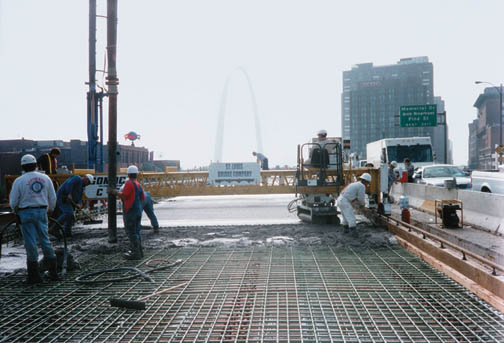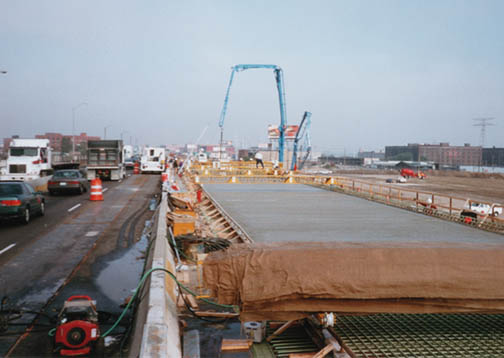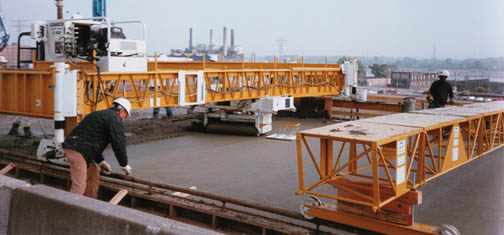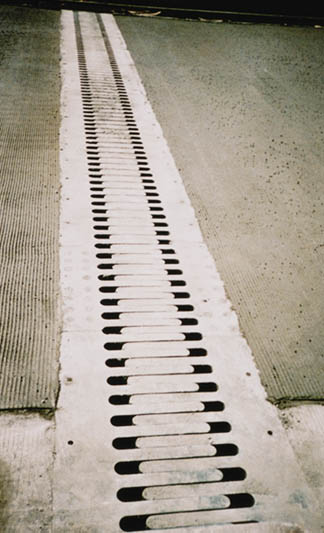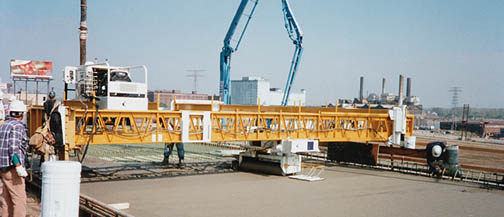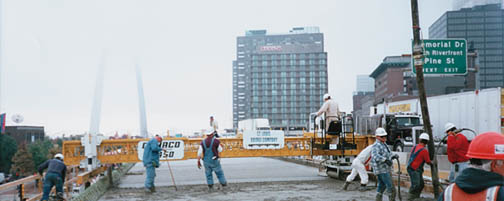GOMACO World Index --- GOMACO World 27.2 - April 1999
Preparation...Preparation...Preparation...
St. Louis Bridge Construction Company, located in Arnold, Missouri, has owned GOMACO machinery "forever."
Maybe "forever" is stretching it a bit, but not by much. They were the first company to use a GOMACO bridge deck finisher on a state of Missouri bridge deck. In fact, in 1971, they were instrumental in getting the C-450 approved in the state.
Now, almost 30 years later, the C-450 remains their bridge deck finisher of choice. They are using two to reconstruct the Cole Street Overpass. The overpass, which is Highway 70 through downtown St. Louis, was built as part of the original interstate program of the 1950s. Old age and heavy traffic loads have taken their toll on the structure.
"The actual bridge deck itself was falling apart," said Patrick Dolan, vice president of operations for St. Louis Bridge. "Huge holes developed in it because it just couldn't take the concentrated traffic loads."
A $17.5 million rehabilitation project began in August 1997. The four-phase project entails the total replacement of the bridge deck, structural steel modifications, seismic retrofitting of the structural steel bearings, new substructure for an entrance and exit ramp on the bridge itself, and the reconfiguration of the city streets beneath the overpass.
The actual contract completion date is June 2000, but Dolan anticipates having it completed by November 1999. Dolan cites "outstanding performance" as one of the reasons for the early completion date. "It just takes a lot of careful planning. You have to make sure all your materials are in place, ready to go, the jobs are staffed with the correct number of craft workers, and don't let certain things trip you up that you know will," he explained.
Two C-450's are being used for the 26 pours required to complete the bridge deck. "Because of the different configurations we needed in the machines, we're using two," Dolan said.
The pours are made in a checkerboard pattern, based on a pouring sequence from the state. "We're allowed to submit different pouring plans as long as the pours stay with the main sequence," Dolan said. "It all has to do with the deflections, the structural steel, the hanging expansions and things like that."
The bridge deck is being poured 216mm (8.5 in) thick. Missouri Highway Department B-2 concrete is placed on the deck using both a belt placer and a pump. The mix, because of its high cement content and low slump, 64 to 76mm (2.5 to 3 in), is hard to work with. Dolan offered a trick to make it easier. "It's just like pouring concrete on grade," he explained. "We always keep a water hose out there and keep our forms wet. If you don't, your form material is dried out and the minute you place the concrete on it, it starts drying the mix out."
An average pour is 229m3 (300 yd3). "A 229m3 (300 yd3) deck pour at 54m3 (70 yd3) per hour, that's good production," Dolan said. "That's excellent production."
Widths of the pours are varied. The widest pour was 18.29m (60 ft) and the narrowest was 8.84m (29 ft). The varying widths have added to the complications.
"The most difficult aspects are where the entrance ramp and exit ramp tie into the structure. The entrance ramp is in the westbound lanes and the exit ramp is in the eastbound lanes. It's a fairly big area, about 18.29m (60 ft) wide, and we have to taper down to about a 13.41m (44 ft) wide area," Dolan explained.
"We had length limitations on the machine that we had to try to avoid because we had traffic signal poles sticking up that were right alongside the bridge," Dolan said. "We couldn't let it adjust out the other side because it would have been sticking into traffic."
The four different stages of the project presented other challenges with sloping and crown. "It all crowns in the center, so stage one was all just a straight slope. Stage two, we had to offset the crown because it was closer to the stage one side than the stage three side. Stage one and three are going to be straight cross slopes to the outside but, in stage two, we had to offset the crown of the machine for the width of the whole stage." Dolan went on to explain, "It wasn't just an easy, even crown right in the middle. It had to be set off to the one side. We had to tie into the slope that we'd already poured for stage one and make sure we hit our proper crown elevation where it's supposed to be."
The adjustability of the machine helped St. Louis Bridge accomplish the pour. "We didn't need our power transition adjuster (PTA). We just used specific sections of the machine, like a 3.05m (10 ft) and a 0.61m (two foot), that got us right to the spot where our crown goes." Dolan said. "We just crowned the machine ourself because of the constant crown down the bridge deck."
Many factors have to be considered to make a successful bridge deck pour. Dolan pointed out three of them. "There's three factors in a bridge deck pour: preparation, preparation, and preparation.
"The bridge deck pour is kind of the culmination of the whole bridge building event," Dolan explained. "You can build the most beautiful substructure in the world and if you have a bad riding surface nobody will ever say, 'Boy, that's a good looking bridge!' Instead, they'll talk about how terrible the thing rides."
Another important aspect of a successful pour is getting the rails set right. "When we talk about setting the machine, that's what you do, you set the rails," Dolan said. "If the rails are set correctly, you never have to touch the machine through the whole pour. We take a lot of time making sure the rails are set correctly.
"The other secrets are preparation, preparation, and preparation," he added. "I just can't say enough about that. Like I said, the bridge deck pour is the culmination of the whole job. It really is. If you mess that up, you've just messed up your whole job."
Before starting the project, St. Louis Bridge added a new C-450 to their fleet. Dolan noted several improvements made to the new machine, such as "...the independent chain drive of the carriage, the operator being able to control the carriage travel, and the basic hold-down of the carriage. Before we always thought, 'Why fix it if it ain't broke?' The older C-450's were working and they were producing an excellent bridge deck."
Since purchasing their new C-450, St. Louis Bridge has increased their pour rate and the machine has exceeded their expectations. "It keeps up with as much concrete as we can place in front of it," Dolan said.
The company's next project is a contract with the city of St. Louis for work on the historic Eads Bridge. The three year project will include a new bridge deck, restoration, and a new riding surface for vehicular travel. It just so happens that the Eads Bridge is St. Louis Bridge's company logo.
Subscribe to Receive GOMACO World Magazine
